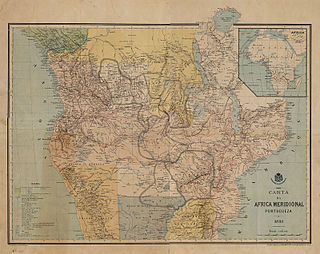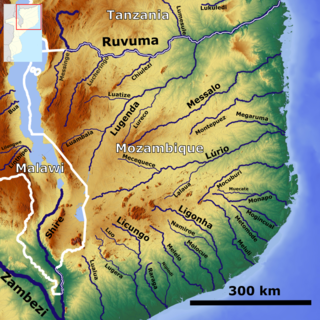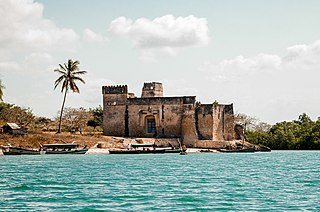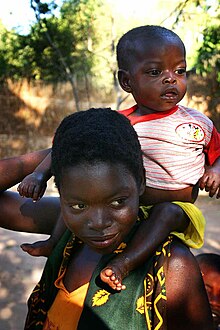
Mozambique, officially the Republic of Mozambique, is a country located in southeast Africa bordered by the Indian Ocean to the east, Tanzania to the north, Malawi and Zambia to the northwest, Zimbabwe to the west, and Eswatini and South Africa to the southwest. The sovereign state is separated from the Comoros, Mayotte and Madagascar by the Mozambique Channel to the east. The capital and largest city is Maputo.

The Kionga Triangle was a small region of German East Africa situated at the mouth of the Ruvuma River. The Ruvuma served as the border between the German colony and Portuguese Mozambique, and the Kionga Triangle was the only section of German East Africa south of the river. Its principal settlement was Kionga which had a population of 4,000 in 1910. It became a German possession in 1894 but came under Portuguese control in April 1916 during World War I. The post-war Treaty of Versailles reaffirmed that the river was the border between Tanganyika, then under British control, and Portuguese Mozambique. The triangle was the only territory that the treaty awarded to Portugal.

Elmina, also known as Edina by the local Fante, is a town and the capital of the Komenda/Edina/Eguafo/Abirem District on the south coast of Ghana in the Central Region, situated on a bay on the Atlantic Ocean, 12 kilometres west of Cape Coast. Elmina was the first European settlement in West Africa and it has a population of 33,576 people.

The Merina people are the largest ethnic group in Madagascar. They are the "highlander" Malagasy ethnic group of the African island and one of the country's eighteen official ethnic groups. Their origins are mixed, predominantly with Austronesians arriving before the 5th century AD, then many centuries later with mostly Bantu Africans, but also some other ethnic groups. They speak the Merina dialect of the official Malagasy language of Madagascar.

Mueda is the largest town of the Makonde Plateau in northeastern Mozambique. It is the capital of the Mueda District in Cabo Delgado Province. It is the center of the culture of the Makondes, and the production of their ebony sculptures.
A prazo in Portuguese Africa was a large estate leased to colonists, settlers and traders to exploit the continent's resources. Prazos operated like semi-feudal entities and were most commonly found in the Zambezi River valley.

The Angoche Sultanate was established in 1485 along an archipelago off the Northern Mozambique coastline. Centered on the cities of Angoche and Moma, the Sultanate also had a number of vassal territories surrounding them. They were finally removed from power by the Portuguese colonial government in 1910.

The Pink Map, also known in English as the Rose-Coloured Map, was a map prepared in 1885 to represent Portugal's claim of sovereignty over a land corridor connecting their colonies of Angola and Mozambique during the Scramble for Africa. The area claimed included most of what is currently Zimbabwe and large parts of modern Zambia and Malawi. In the first half of the 19th century, Portugal fully controlled only a few coastal towns in Angola and Mozambique. It also claimed suzerainty over other almost independent towns and nominally Portuguese subjects in the Zambezi valley, but could rarely enforce its claims; most of the territory now within Angola and Mozambique was entirely independent of Portuguese control. Between 1840 and 1869, Portugal expanded the area it controlled but felt threatened by the activities of other powers.

Maganja da Costa District is a district of Zambezia Province in Mozambique.
The Shirazi also known as Mbwera, are a Bantu ethnic group inhabiting the Swahili coast and the nearby Indian ocean islands. They are particularly concentrated on the islands of Zanzibar, Pemba and Comoros.

The Makoa are an ethnic group in Madagascar descended from enslaved people from mainland Africa that were traded through the major slave trading ports of northern Mozambique in an area mainly populated by the Makua people. They are among the last African diaspora communities in the world to issue from the slave trade. They are sometimes classified as a subgroup of the fishing peoples known as the Vezo, although the Makoa maintain a distinct identity, one reinforced by their larger physical stature and historic employment as police officers by the French colonial administration.

The Sena people are a Bantu ethnolinguistic group with origins in northwestern region of Mozambique, Sofala Province and Zambezia Province. They are also found in Malawi and Zimbabwe near their respective borders with Mozambique.

The Lúrio is a river of northeastern Mozambique. It flows to the south of the Ruvuma River and empties into the sea just south of Pemba Bay. The river is characterised by seasonal flows and lined by swamps. There is a notable waterfall located along the river. The Mozambican government has plans to build a 120-megawatt hydroelectric plant on the river to supply electricity to the surrounding provinces of Nampula and Cabo Delgado.
Pemba Bay is a very large bay on the Indian Ocean of northeastern Mozambique.
Luso-Africans are people of mixed Portuguese and African ancestry who speak Portuguese. The vast majority of Luso-Africans live in former Portuguese Africa, now referred to as Lusophone Africa, comprising the modern countries of Angola, Guinea-Bissau, Cape Verde, Mozambique, São Tomé and Príncipe, and Equatorial Guinea. A sizable number of Luso-Africans have also settled in Portugal where they form a racial minority. This ethnic identity arose from the sixteenth century as primarily male Portuguese settlers, often Lançados, settled in various parts of Africa, often marrying African women.

The Andevo, or slaves, were one of the three principal historical castes among the Merina people of Madagascar, alongside the social strata called the Andriana (nobles) and Hova. The Andevo, along with the other social strata, have also historically existed in other large Malagasy ethnic groups such as the Betsileo people.
The M'Bona Cult is a system of religious beliefs and rituals which is currently restricted to the most southerly parts of Malawi, but which probably extended more widely, both in other parts of Malawi and adjacent parts of Mozambique. The cult is found mainly among the local Mang'anja people and its former extent reflected that people's wider past distribution. It aims to secure abundant rains at the appropriate season through the making of propitiatory gifts at cult shrines, and includes rainmaking rituals in the event of drought. It has been related to a number of other territorial cults among the Maravi cluster of related African peoples which aim to secure the well-being of the people of a particular area secure from drought, floods or food shortages. The cult is believed to be a long established one, although estimates of how long it has existed are speculative, as the earliest definite record of its existence dates from 1862.
Chikunda, sometimes rendered as Achicunda, was the name given from the 18th century onwards to the slave-warriors of the Afro-Portuguese estates known as Prazos in Zambezia, Mozambique. They were used to defend the prazos and police their inhabitants. Many of the chikunda were originally chattel slaves, raised to the status of soldiers, traders or administrators of parts of the prazo as a client or unfree dependent.

Fort Santiago is the name of a former Portuguese military installation in the island of Kilwa, in Tanzania. It's nowadays known as Arab Fort or Gereza Fort. It is situated between the Makutani Palace and the Great Mosque.

The Portugal–Angoche conflict refers to a series of wars between the Angoche Sultanate and the Portuguese Empire between 1847 and 1910.
















